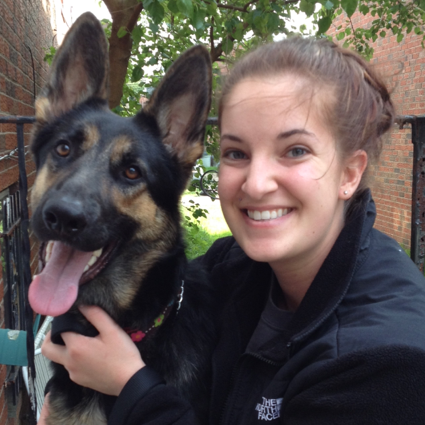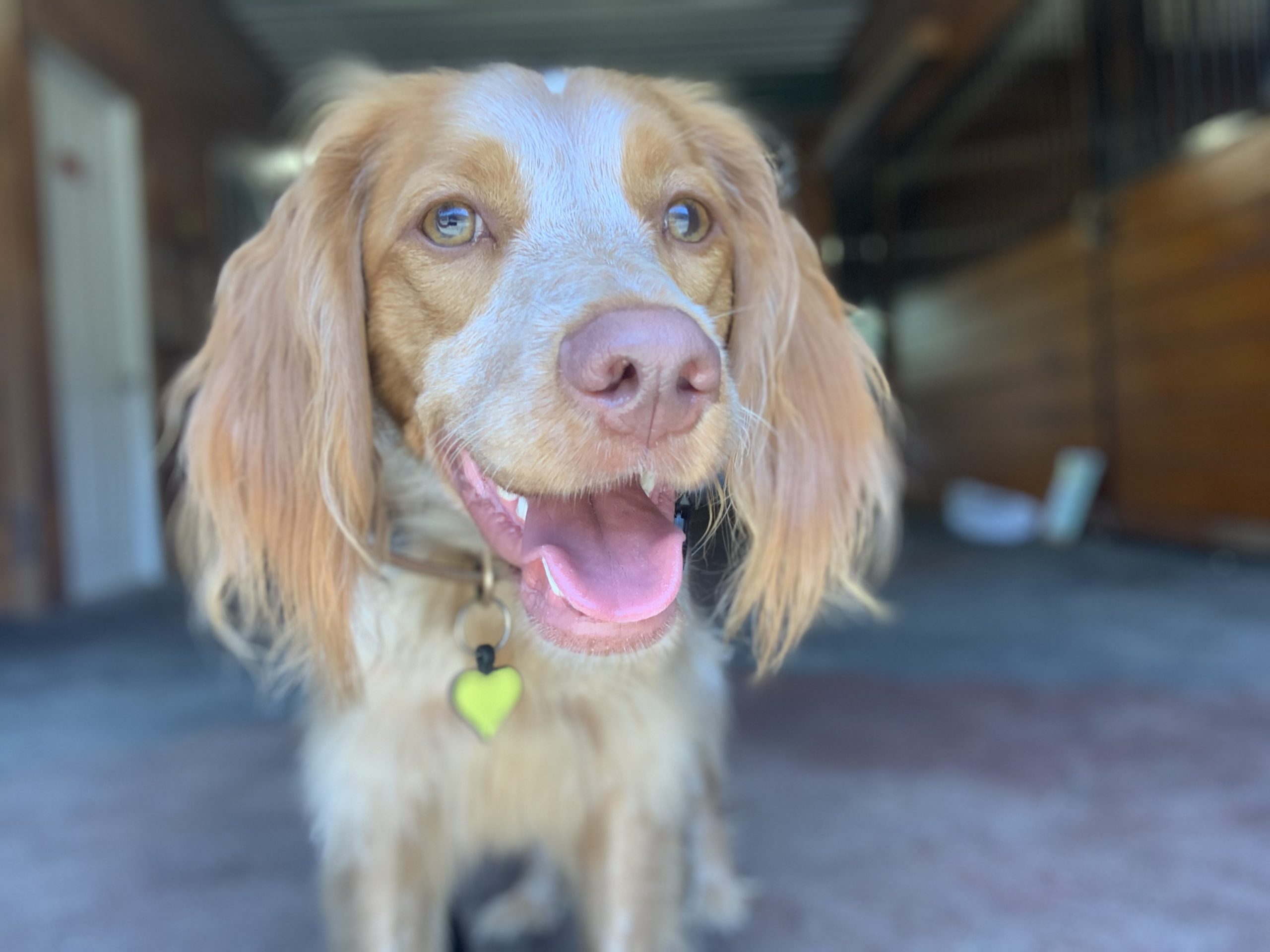Of course, we know our dogs need to eat, potty, sleep, and socialize a bit! However, if we dig a little deeper, and take a look at the day-to-day experiences they have, it’s important to see if we’re working to meet each of their canine needs. Otherwise, we’re tossing some kibble in a bowl, slurping down a cup of coffee, and getting on with our days. Making sure these boxes are checked each day or at least a few times a week will help curb some common nuisance behaviors (even ahead of training!) and help your dog live a more enriched and fulfilled life, allowing you to appreciate your dog a bit more for “doing dog things.”
Physical Exercise
One of the first and most obvious needs is physical exercise. This is true of any dog at any age, and can come in various forms from playing fetch in the living room each evening to going on long, arduous hikes for hours. The important part is knowing how much physical exercise is just enough as too little exercise can keep your dog feeling a little feisty and too much exercise can lead to injuries or frustration if you’re expecting something else of them later on in the day. We recommend at least two to three walks a day, about 10 to 15 minutes each, and some playtime between as a place to start for a fit and happy pup. Of course, if you’re still house-training or have an extra active pup or lifestyle, adjust accordingly!
If your dog is so fit and amped that just a few walks and fetch throughout the day isn’t enough, reach out to us and see if they might be a good fit for Dog Sports – we offer all kinds of options from agility to rally and trick training at the farm and in the city! A dog who is good at running and jumping will certainly succeed in Agility class with a little bit of help in training.

Mental Stimulation
We’ve all heard the phrase “a tired dog is a happy dog”. In my opinion, that phrase should really be is “a mentally stimulated dog is a happy dog.” Dogs are physical animals. A stray dog or even a wolf might survive day to day without the supports of domestication and living in a household, but it’s a lot of moving and sleeping with little guarantee for a meal and lots of work to eventually capture or scavenge for those calories. We meet our dogs’ caloric intake needs every day, twice a day at least! So of course they can go on a three-mile run and still have loads of energy. They’re genetically designed to go-go-go… physically.
When you ask them to think, however, or use some of their other natural senses (like sniffing for a cookie you’ve tossed or hidden nearby!) it is much like switching from hopscotch to a Sudoku puzzle. I like to use that analogy because it also helps define how your dog might feel about puzzle toys or “thinking” games: some dogs will love it and want more, others will feel frustrated by the challenge in which it isn’t going to help check this particular box for them.
Creatively find mental exercises for your dog. We like to use these games and activities at home with our dogs across the Philly Unleashed team:
- Find It!: tossing treats or kibble in the house, or in a grassy patch on a walk outside. If you put a Fitbit on your pup while playing this game, you could clock a mile or two while you sit and toss treats! It’s a great two-for-one for exercise AND mental stimulation.
- Hide & Seek: treat, toy, or favorite person! Ask your dog to sit and wait or stay, then hide the item (or yourself!) and release them to seek it out. It’s a really fun scavenger hunt that you can make easier or harder based on your dog’s interest level and success each game.
- Recycling Bin Enrichment: so long as your dog won’t eat (see: consume) the cardboard or plastic, we love using plastic bottles or cardboard paper towel rolls to make food toys for our pups. It’s easy, free, and while it makes a mess while they shred the paper and plastic, it’s far better than watching that same thing happen to your favorite pair of flip flops.
- Lastly, TRAINING! Training sessions, however short and sweet, are a wonderful way to get your dog’s mind engaged while also teaching them what you expect to carry over from classes into everyday life. Try some sit/stays in the kitchen while you brew coffee, or practice loose-leash walking a new way: off-leash and up and down the hall indoors! You can even include some training in the games above, like using your recall cue to release your pup in hide-and-seek as a fun way to practice.
Freedom of Motion
Our dogs spend a lot of their lives in a somewhat (or in some cases, very) restricted state. Short leashes, tight spaces, and crate or boundary training are all parts of everyday life but much like how we like to leave the city and hit the mountains or the shore once in a while, our dogs need a chance to spread out, run around, and take some deep breaths while doing it.

We love decompression walks (a term coined by trainer Sarah Stremming, but discussed widely across the positive reinforcement training community) as a chance to let your dog loosen up quite literally, and exercise some of the natural dog things they’re inclined to do… and sometimes get in trouble for. These include chasing, digging, sniffing, and otherwise existing in nature, something that’s hard to do in the middle of Philadelphia. With just a short drive to one of the amazing parks nearby, though, everyone can appreciate a lovely field trip.

To enjoy a decompression walk, you’ll need a long leash (non-retractable!) of about 15+ feet, some treats, and a natural destination. This could be Wissahickon Park for a hike, your local city park for a sniff in the grass, or a field trip to anywhere that’s a bit different than your home environment. The goal is to find a spot with open space and lots of sniffs for your dog to explore and enjoy. The treats are to reward good behavior (this isn’t necessarily a training session) or to play training games (like the ones above!) to improve their experience!
Using Their Mouth
Speaking of dogs doing dog things, some breeds are far more apt to use their mouths than other breeds for a variety of reasons (see Golden Retrievers who love to carry things in their mouths, or German Shepherds who are very vocal about how they feel at most moments) and giving them appropriate ways to do so can help balance out their behavior across all environments.
For example, if your dog likes to steal your shoes and chew on them every morning, the first thing to do would be to remove the shoes from their access. But, without replacing the activity, they’ll find something else to get into! So the next step is to offer them a more appropriate option during that same time they’d normally be chomping away at your Jimmy Choos like a bully stick, nylabone, pig’s ear, or other awesome option.

If your dog constantly picks things up on walks, or tries to help you out by carrying the leash, try bringing a tug toy or tennis ball along to redirect the behavior, or allowing them to carry the first stick for a while before asking them to drop the item for a treat from your pocket.
Licking
Licking and chewing can sometimes manifest as unwanted behaviors around our furniture, or even onto our dogs! Dogs who lick their paws incessantly or come in for way too many kisses than you’d like to receive can be satisfied otherwise with a licki-mat or stuffed kong toy to help them exercise their jaws and natural behavior on something else. Some great options for filling a kong include wet dog food, peanut butter, some cream cheese (but not too much!), and slightly oversized biscuits or treats that would be a little bit of an easy challenge for your dog to take out. If you’d like to go full foodie, check out some of these super inspiring recipes from Bindi’s Bucket List on Instagram!
Digging
Digging is one of those behaviors that your dog either comes with or without. Sometimes it can be learned along the way, and other times you’ll have a dog that never uses its paws for a single thing besides trotting around the block and looking fancy with them crossed around the house. If you’ve got a dog that digs, though, you know who you are… and I’m here to offer some tips to help!

Sometimes having a designated “Dig Zone” (think yellow tape construction site) can help your dog exhaust this behavior in a more controlled area instead of across the whole yard. This could be a soft patch of dirt that you encourage and allow your dog to dig at, a sandbox that you keep for this fun activity, or a spot on your walk (that isn’t someone else’s front yard!) you can use as a digging destination for your pup. If these don’t seem like doable options, you can create or buy puzzle toys that encourage digging from your dog, or use their paws in training for other behaviors like “paws up,” pedestal training, skateboarding, or self-filing nail boards for nail trims.
This week, here is my challenge for you: pick one day to make a list of all the “nuisance” behaviors you wish your dog would curb and see if you can add an extra column next to each point with some way you can help your dog exhaust that behavior differently. If you have trouble coming up with some ideas, or if you find yourself checking every box and still struggling to get a balanced day with your dogs, reach out to our trainers for some help and we’ll get you started with some lessons, obedience classes, agility courses, or whatever else your dog might individually need to succeed moving forward!



Thanks sooooo for providing such important tips. Your posts are ‘pawsitively’ easy to envision, quick to absorb mentally and chock full of great tips for keeping any canines engaged, healthy and balanced. And………tons of ‘individuality’ and ‘personality’ shine through in the eyes of the dogs in the photos. Their shiny coats, trusting eyes, and attentive expressions reinforce your pawitive connection with each one.. You certainly ‘unleash’ their natural talents Makes me wish we had a place like Philly Unleashed in Massachusetts . PAWSOME Posts.
Comments are closed.